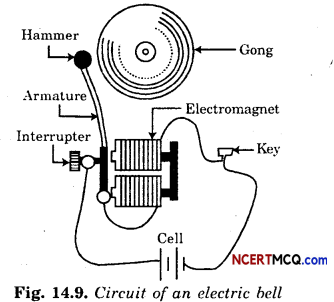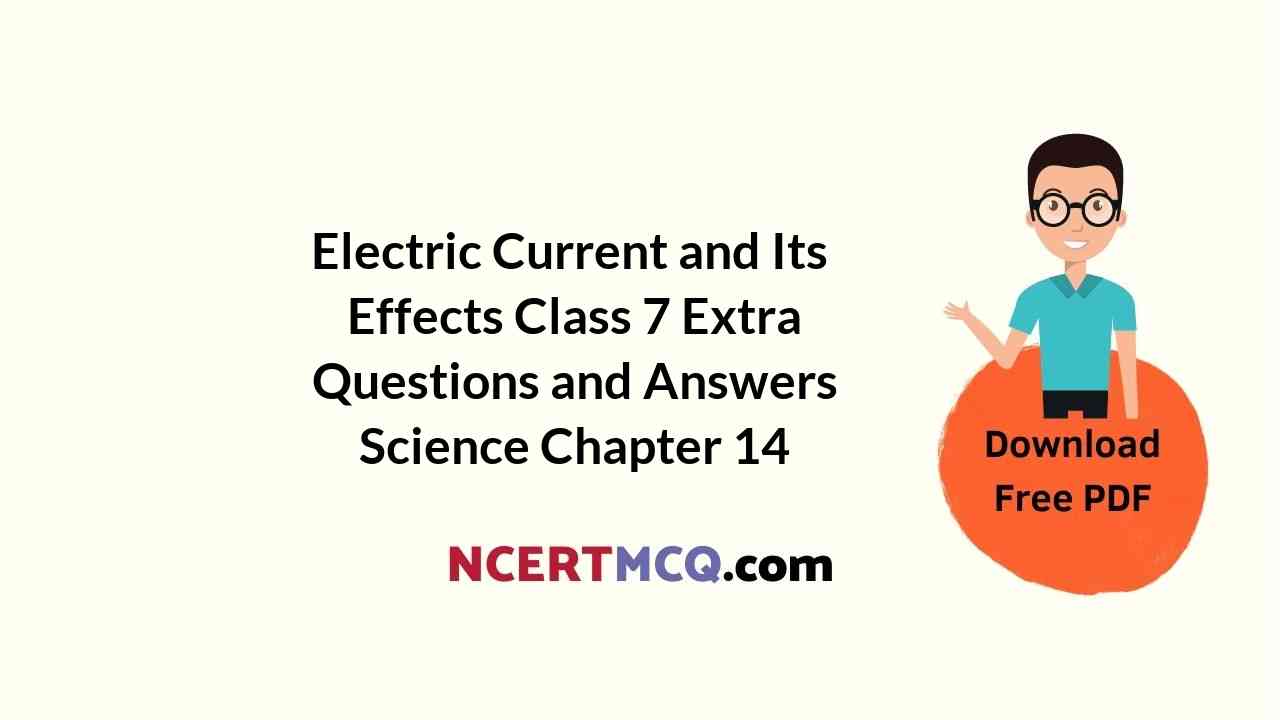Check the below Online Education NCERT MCQ Questions for Electric Current and Its Effects Class 7 Extra Questions and Answers Science Chapter 14 with Answers Pdf free download. https://ncertmcq.com/extra-questions-for-class-7-science/
Online Education for Class 7 Science Chapter 14 Extra Questions and Answers Electric Current and Its Effects
Electric Current And Its Effects Class 7 Extra Questions And Answers Question 1.
Which terminal of a cell is represented by longer line?
Answer:
Positive.
Electric Current And Its Effects Class 7 Extra Questions With Answers Question 2.
Where should be the key placed in a circuit?
Answer:
The key or switch can be placed anywhere in the circuit.
Class 7 Science Chapter 14 Extra Questions Question 3.
What is a filament?
Answer:
In the bulb, there is a thin wire, called the filament, which glows when an electric current passes through it.
Electric Current And Its Effects Class 7 Question Answer Question 4.
What is the full form of CFL?
Answer:
Compact Fluorescent Lamp.
![]()
Ncert Solutions For Class 7 Science Chapter 14 Extra Questions Question 5.
What is the full form of MCB?
Answer:
Miniature Circuit Breaker.
Class 7 Electric Current And Its Effects Extra Questions Question 6.
Who discovered magnetic effect of electric current?
Answer:
Hans Christian Oersted.
Class 7 Science Chapter 14 Extra Question Answer Question 7.
What are complete and incomplete circuits?
Answer:
When the switch is in the ‘ON’ position, the circuit from the positive terminal of the battery to the negative terminal is complete. The circuit is then said to be closed and the current flows throughout the circuit instantly.
When the switch is in the ‘OFF’ position, the circuit is incomplete. It is said to be open. No current flows through any part of the circuit.
Electric Current And Its Effects Class 7 Question 8.
Why should we not touch a lighted electric bulb connected to the mains?
Answer:
We should not touch a lighted electric bulb connected to the mains because it may be very hot and our hand may get burnt badly.
Ncert Class 7 Science Chapter 14 Extra Questions Question 9.
How does a fuse work?
Answer:
Every fuse is designed to carry current up to a certain maximum limit. If the current crosses that limit, the fuse wire melts due to heating effect of current and breaks the circuit. Thus, the circuit is saved.
Electric Current And Its Effects Class 7 Questions And Answers Question 10.
What are the uses of electromagnets?
Answer:
- The electromagnets are also used to separate magnetic material from the junk.
- Doctors use tiny electromagnets to take out small pieces of magnetic material that have accidentally fallen in the eye.
- Many toys also have electromagnets inside them.
- Electromagnets are used in electric bells.
Class 7 Science Ch 14 Extra Questions Question 11.
Discuss the reason for excessive \ currents in electrical circuits.
Answer:
- One reason for excessive currents in electrical circuits is the direct touching of wires. This may happen if the insulation on the wires has come off due to wear and tear. This may cause a short circuit.
- Another reason for excessive current can be the connection of many devices to a single socket. This may cause overload in the circuit.
![]()
Electric Current And Its Effects Extra Questions Question 12.
Write construction and working of an electric bell.
Answer:
Construction: It consists of a coil of wire wound on an iron piece. The coil acts as an electromagnet. An iron strip with a hammer at one end is kept close to the electromagnet. There is a contact screw near the iron strip.
Working: When the iron strip is in contact with the screw, the current flows through the coil which becomes an electromagnet. It, then, pulls the iron strip. In the process, the hammer at the end of the strip strikes the gong of the bell to produce a sound. However, when the electromagnet pulls the iron strip, it breaks the circuit. The current through the coil stops flowing.

The coil is now no longer an electromagnet. It no longer attracts the iron strip. The iron strip comes back to its original position and touches the contact screw again. This completes the circuit. The current flows in the coil and the hammer strikes the gong again. This process is repeated in quick succession. The hammer strikes the gong every time the circuit is completed. This is how the bell rings.
Chapter 14 Science Class 7 Extra Questions Question 13.
When the current is switched on through a wire, a compass needle kept nearby gets deflected from its north-south position. Explain.
Answer:
When electric current passes through a wire, it behaves like a magnet. This is the magnetic effect of the electric current. So, the compass needle which is a magnet gets deflected.
Electric Current And Its Effects Class 7 Extra Questions Question 14.
Do you know what a battetis?
Answer:
When we connect two or more cells together such that the positive terminal of one cell is connected to the negative terminal of the next cell, such a combination of cells is called a battery.
Ncert Class 7 Science Electric Current And Its Effects Extra Questions Question 15.
Zubeda made an electric circuit using a cell holder shown in Fig. 14.4, a switch and a bulb. When she put the switch in the ‘ON’ position, the bulb did not glow. Help Zubeda in identifying the possible defects in the circuit.
Answer:
Possible defects can be:
- bulb taken would be fuse.
- cell taken could be exhausted.
- in cell holder, she would have connected the same terminals of the cells.
Extra Questions On Electric Current And Its Effects Class 7 Question 16.
Set up the circuit shown in Fig. 14.17 again. Move the key to ‘ON’ position and watch carefully’ in which direction the compass needle gets deflected. Switch ‘OFF’ the current. Now keeping rest of the circuit intact, reverse the connections at the terminal of the cell. Again switch ‘on the current. Note the direction in which the needle gets deflected. Think of an explanation.
Answer:
When the connection of cell is reversed, the compass needle moves in opposite direction. This shows that the polarity of the magnet depends on the direction of flow of current.
![]()
Ch 14 Science Class 7 Extra Questions Question 17.
Paheli and Boojho saw a magic trick sometime back. The magician placed an iron box on a stand. He then called Boojho and asked him to lift the box. Boojho could easily lift the box. Now the magician made a show of moving his stick around the box while muttering something. He again asked Boojho to lift the box. This time Boojho could not even move it.
The magician again muttered something and now Boojho could lift the box. The audience, including Pahei and Boojhó, were very impressed with the show and felt that the magician had some supernatural powers. However, after reading this chapter Paheli is wondering if the trick was indeed some magic or some science was involved? Car you guess what science might Involved?
Answer:
The magician arranged an electromagnet below the box. The electromagnet could be turned ‘ON’ and ‘OFF’ as when the magician signals his assistance. When the electromagnet is turned 0N’ it attracts the iron box and hence it could not be lifted.
Multiple Choice Questions
1. Which of the following is a completely closed circuit?
(i) Switch key is off.
(ii) Wire connecting battery and bulb is broken.
(iii) Simple circuit with glowing bulb.
(iv) Circuit with bulbs with broken filament.
Answer:
(iii) Simple circuit with glowing bulb.
2. In a circuit, cell is attached if:
(i) only positive terminal is attached to the circuit.
(ii) only negative terminal is attached to the circuit.
(iii) both positive and negative terminals are attached to two different wires for completing the circuit.
(iv) both positive and negative terminals are attached to a single wire.
Answer:
(iii) both positive and negative terminals are attached to two different wires for completing the circuit.
![]()
3. Which of the following is an effect of electric current?
(i) Heating effect only
(ii) Magnetic effect only
(iii) Both heating and magnetic effect.
(iv) Neither heating nor magnetic effect.
Answer:
(iii) Both heating and magnetic effect.
4. When a bulb is switched ON in a circuit, which of the following happens?
(i) The bulb becomes cold.
(ii) The bulb becomes hot.
(iii) No change occurs in temperature of the bulb.
(iv) The temperature of bulb is equal to room temperature.
Answer:
(ii) The bulb becomes hot.
5. Which of the following electric appliances do not make use of heating effect of current?
(i) ilectric hejter
(ii) Electric bulb
(iii) Electric eil
(iv) Electric iron.
Answer:
(iv) Electric iron.
6. The amount of heat produced in a wire is independent of 4ts:
(i) material and length only
(ii) length and thickness only
(iii) thickness and material Only
(iv) material, length and thickness.
Answer:
(iv) material, length and thickness.
![]()
7. Which material can be used for making fuses?
(1) Nichrome
(ii) Tungsten
(iii) Steel wool
(iv) Copper.
Answer:
(iii) Steel wool.
8. Excessive current due to the connection of many devices to a single socket is termed as:
(i) short circuit
(ii) overload
(iii) electric magnification
(iv) none of these.
Answer:
(ii) overload.
9. Excessive current due to direct touching of wires in an electrical circuit is termed as:
(i) short circuit
(ii) overload.
(iii) electric magnification
(iv) none of these.
Answer:
(i) short circuit.
10. Current in a circuit deflects needle of a compass. This shows effect of electric current.
(i) heating
(ii) chemical
(iii) magnetic
(iv)none of these.
Answer:
(iii) magnetic.
![]()
11. The needle of a compass point in …………………………….. direction.
(i) east-west
(ii) north-south
(iii) north east-south west
(iv) south east-north west.
Answer:
(ii) north-south.
12. Which of the following statements is true for electromagnets?
(i) Electromagnets are permanently magnetised.
(ii) Electromagnets lose magnetism when electric current is switched off.
(iii) They are used to magnetise other magnetically active substances.
(iv) None of these.
Answer:
(ii) Electromagnets lose magnetism when electric current is switched off.
13. Which of the following appliances uses magnetic effect of current?
(i) Electric heater
(ii) Electrician
(iii) Electric bell
(iv) Electric bull
Answer:
(iii) Electric bell.
Keywords:
→ Battery: A battery is a combination of two or more cells, such that the positive terminal of one cell is connected to the negative terminal of the next cell.
→ Electric components: Electrical devices used in a circuit are called electric components.
→ Circuit diagrams: Symbolic representation of an electric circuit.
→ Electric bell: An electrical device that produces sound when its switch is turned on.
→ Electromagnet: A coil that behaves like a magnet when electric current flows through it. is called an electromagnet. When the electric current is switched off, the coil generally loses its magnetism. Such coils are called electromagnets.
![]()
→ Fuse: It is a safety device used in an electric circuit to avoid abrupt electric flow.
→ Heating effect: The wire gets hot when an electric current passes through it. This is the heating effect of the electric current.
→ Magnetic effect: When electric current passes through a wire, it behaves like a magnet. This is called the magnetic effect of the electric current.
